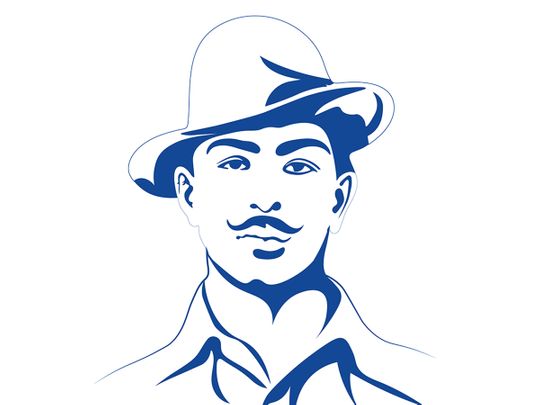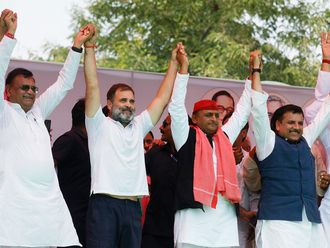
In India’s independence struggle against the British Raj, there was almost an elbowing of heroism; in the crowd were known faces, unknown citizens all joined by a common thread, a fierce burning to set India free. In that landscape dotted every few steps by acts of valour, was Bhagat Singh the bravest freedom fighter as popular imagination would have us believe? Even today on his 116th birth anniversary the freedom fighter stands tallest in the pantheon of the tall. Yet is he but a ceremonial idol?
His image with a hat — after the Saunders’ killing, the man who was born in a Sikh family cut his long hair and shorn his beard to go incognito — is romanticised as much as the deeds of a young man who was hanged when he was just 23 years of age. But this upcycling of his popularity that is based only on the knowledge of his fearlessness shows how little contemporary India understands him.
The young man was a thinker who married his ideology to the cause of attaining freedom; for him one without the other was incomplete. Also, contrary to the overwhelming perception his idea of a revolution was far removed from the widespread assumption that he prescribed openly to violence. He opposed bloodshed and believed that sacrifice for violence’s sake was futile.
Why Bhagat Singh became popular
“Bhagat Singh did not become popular because of his act of terrorism but because he seemed to vindicate, for the moment, the honour of Lala Lajpat Rai and through him of the nation. He became a symbol, the act was forgotten, the symbol remained,” Jawahar Lal Nehru summed up Bhagat Singh better than many.
Historians say he regretted the killing of Saunders and the only other hostile incident involving the revolutionary was the harmless attack in the assembly to stop the passing of a Public Safety Bill that would compromise the civil liberties of the Indians. The intensity of the bombs had been tested earlier to ensure no one would be harmed. “Bombs and pistols do not make a revolution,” he emphasised. “The sword of revolution is sharpened on the whetting stone of ideas.”
The public, he felt, must be able to appreciate the need for a revolution and that was impossible without an atmosphere created by conspicuous sacrifice. This Bhagat Singh sensed only he could do, fusing individual heroism with group ideology. In the neo-nationalist ecosystem, it is almost fashionable to dismiss the sacrifices for India’s independence casually.
Like at the [Indian] farmers’ protest, the youth and the working class continue to be inspired by him [Bhagat Singh], and he speaks of injustice through them, irrespective of the direction of the political winds.
Those who spew hate from anonymous handles online will never understand the bravery of refusing to escape knowing death could be the punishment. After throwing the bombs in the assembly, Singh and his comrade Batukeshwar Dutt waited on their seats to be arrested. “If the deaf have to hear, the sound has to be very loud.” Did the revolutionaries sacrifice more than those who pursued independence through non-violence? It is a debate for another day.
Sadly, Bhagat Singh the philosopher is often overpowered by the physical deeds and defiance of a young man to the mighty British Raj; it is an image far more glamorous than a rationalist espousing his thoughts on a just society and actively endorsed by a lazy commercial Bollywood — contrary to the images circulated Bhagat Singh never wore a yellow turban. His nationalism though was the real deal and far removed from the muscular version our society displays today.
A revolutionary who thought not only with his heart but equally with his head, his syncretism is reflected in the intellectual legacy he bequeathed, uncomfortable strain of thoughts for those whose footprints are missing from the annals of the freedom movement. An advocate of an egalitarian society, Singh consistently questioned the role of religious dogmas and was a firm believer that ‘if religion is separated from politics, then we can all come together in politics even if we belong to different religions.’ We couldn’t have moved further away from his beliefs.
Bhagat Singh: A voracious reader, writer and thinker
Bhagat Singh’s chief demand in jail during his last years was for books and newspapers to be made accessible to political prisoners; he got a continuous supply of literature — Marxist, revolutions and ideological from admirers outside and even sent his list of books to be delivered from libraries in Lahore. A voracious reader, writer and thinker, his reading list was diverse: from Dostoevsky to Dante and Omar Khayyam to Tagore, they helped shape his worldview and critical thinking at the young age he lived to. He left behind a precious collection of writings, which makes him stand out from his peers whose interest was primarily in seeing the British leave.
‘Why I am an atheist’ is also part of his jail memoirs and he openly spoke against communal and religious divide, refusing to offer prayers even as he was led to the gallows. In a polarised country where does he then fit in? His photo was missing from the gallery of portraits in India’s old parliament; it is unlikely to find a place in the new building.
From casteism to communalism, Bhagat Singh was a visionary who while actively pursuing anti-British activities was simultaneously looking ahead to freedom from man-made binaries and its afflictions. Mere replacement of the British by Indians wasn’t his end goal. That he didn’t live to see India’s independence is perhaps less of a tragedy than the lip service done to his memory by those who stand against everything he stood for.
In recent years pages of history have been disdainfully torn out to be replaced by figures whose contributions to India’s freedom struggle remain suspect. The willingness of the freedom fighters to embrace the gallows still sets them apart but in the new order exceptions like Vinayak Savarkar despite the infamy of mercy petitions to the British and in the absence of real heroes from the movement find a second birth.
Notwithstanding attempts, Gandhi though cannot be forsaken in totality because of his international appeal — as was in evidence when G20 leaders paid their respects at his memorial — though much has been done to chip away at the Mahatma’s pedestal allowing his killer Nathuram Godse, with strident right-wing roots, to become mainstream.
Bhagat Singh on the other hand has remained a domestic icon, his enduring popularity lies in transcending to a symbol against oppression. Like at the farmers’ protest, the youth and the working class continue to be inspired by him, and he speaks of injustice through them, irrespective of the direction of the political winds.
Legacy is a complicated word these days. In its new avatar it is not what has been passed down but the whitewashing of that past that makes the narrative. But those wishing to conveniently appropriate him deny his key strength, the unhesitating criticism of his own country when required. Bhagat Singh’s legend lives on, but does his legacy?









